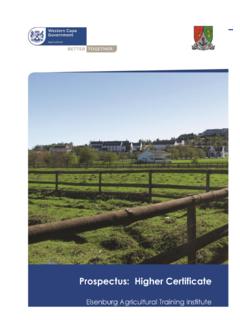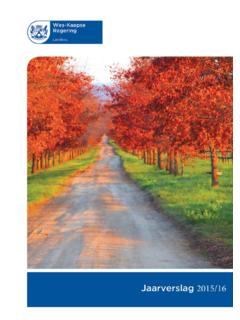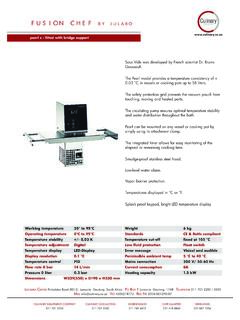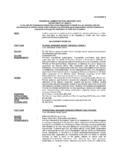Transcription of WESTERN CAPE PROVINCIAL PROFILE - Elsenburg
1 WESTERN cape PROVINCIAL PROFILE Report: WCPP2014 Date of compilation: August 2014 Compiled by the Agricultural Economic Services: Marketing and Agribusiness Contents WESTERN cape PROVINCIAL PROFILE : EMPHASIS ON AGRICULTURAL SECTOR .. 1 POPULATION DEMOGRAPHICS .. 2 PROVINCIAL EMPLOYMENT AND UNEMPLOYMENT STATUS .. 2 EDUCATION LEVELS OF AGRICULTURAL SECTOR .. 4 PROVINCIAL CONTRIBUTION TO THE NATIONAL ECONOMY .. 4 MAIN AGRICULTURAL ACTIVITIES IN WESTERN cape .. 5 PROVINCIAL TRADE STATISTICS .. 5 PROVINCIAL exports .. 5 PROVINCIAL imports .. 7 PROVINCIAL total trade balance .. 9 INFRASTRUCTURE .. 9 Ports 9 National roads .. 10 Airport .. 10 CONCLUSION .. 10 REFERENCES .. 11 1 WESTERN cape PROVINCIAL PROFILE : EMPHASIS ON AGRICULTURAL SECTOR The WESTERN cape s agricultural sector is unique from other provinces in South Africa, mostly in terms of physical resource differences.
2 The winter rainfall region of the Winelands and the year-round rainfall of the Southern cape enable a variety of crop mix and production potential. The Provinces agricultural sector is known for its production stability and supported by well-developed infrastructure for input supply and output processing. It is well-known that agriculture plays a significant role in the WESTERN cape economy with a total value-addition to the economy of billion in 2011, and about 23% of the national agricultural value-addition (Vink & Tregurtha, 2001). This report will seek to highlight the WESTERN cape PROVINCIAL PROFILE with the emphasis on the agricultural sector and how it fits into the greater economy. The WESTERN cape Province is the 4th largest province in South Africa in terms of its land area which amounts to 12,938,600 hectares. The area consist of 11,560,609 hectares ( ) of farm land, 2,454,788 hectares (19%) potentially arable land, 9,105,821 hectares ( ) grazing, 730,731 hectares ( ) nature conservation, 198,938 hectares ( ) forestry and 448,322 ( ) other (DAFF, 2014; Stats SA, 2012).
3 There are five district municipalities in the WESTERN cape namely; cape Winelands, Central Karoo, Eden, Overberg and the West Coast as well as cape Metropole (City of cape Town), which is the only metropole situated in the Province, refer to figure 1. Figure 1: WESTERN cape Municipalities. Source: WC DoA, 2014. 2 POPULATION DEMOGRAPHICS The latest population total for the WESTERN cape by Statistics South Africa (Stats SA) amounted to 6,082,849 people in 2014, with a working population of 4,149,922 individuals (68% aged between 15 and 64 years). Table 1 below gives the population numbers of each age group. The age demographic categories for the WESTERN cape population are as follows: AGE CATEGORY PERCENTAGE 0-14 years of age 15-34 years of age , 35-64 years of age 65 years and older Table 1: Age demographic of the PROVINCIAL population. Source: Stats SA, 2014b.
4 In terms of racial breakdown the majority of individuals in the WESTERN cape are Coloured (3,174,269), followed by Black (1,796,247), White (1,071,087) and Indian (41,246). Figure 2: WESTERN cape population by race. Source: Stats SA, 2014b. PROVINCIAL EMPLOYMENT AND UNEMPLOYMENT STATUS The working population increased by 91,000 people y/y in the first quarter of 2014, which is higher than the same period in the previous year. The total number of people employed in the WESTERN cape amounted to 2,237,000 (7% or 146,000 increase y/y) in the first quarter of 2014 and the total unemployed people for the same period amounted to 593,000 ( decrease y/y). The 1unemployment rate in the first quarter of 2014 is at , which is a decrease y/y, with an 2expanded unemployment rate of The total 3labour force participation rate is , which is an increase of % y/y (Stats SA, 2014d).
5 1 Unemployment rate: proportion of working force which is unemployed and are still looking for a job. 2 Expanded unemployment rate: proportion of unemployed persons including discouraged job-seekers and non-economically active people. 3 Labour force participation rate: portion of working-age population that is either employed or unemployed. African Black 29% Coloured 52% Indian/Asian 1% White 18% WESTERN cape population race PROFILE 3 Figure 3: WESTERN cape employment by sector. Source: Stats SA, 2014d. The WESTERN cape agricultural sector achieved a much higher absorption rate if compared to the national average of for the agricultural sector as indicated by Stats SA. The WESTERN cape employed 23% of the total national agricultural workforce, which is the largest in relation to other provinces. This could be a direct result of the labour intensive agricultural industries such as the horticultural industry in the WESTERN cape for permanent as well as seasonal labour.
6 Figure 4, below provides an illustration of the national and PROVINCIAL absorption by the agricultural sector; the share of the WESTERN cape could be a direct result of seasonality s of the respective commodities produced in the WESTERN cape . Figure 4: National and PROVINCIAL agricultural employment absorption for Quarter 1:2008 to Quarter 1 of 2014. Source: Stats SA, 2008-13 & 2014d. 200820092010201120122013 Community and social services32475235105036619737748438461339 4448 Finance and business24576926005825204627367528818231 5339 Trade38975340181938348239912838678541635 7 Construction1774291724271420101288761381 01142251 Manufacturing318320290376272793290762285 018278540 Agriculture14287613261514482310699712029 21356240%10%20%30%40%50%60%70%80%90%100% Percentage per Industry Employment by sector within the WESTERN cape NATIONAL VS WESTERN cape AGRICULTURAL SECTOR EMPLOYMENT 4 Other 1% Completed tertiary 19% Completed grade 12 22% Completed between grade 1 and 10 53% No schooling 5% Education levels of WESTERN cape agricultural sector EDUCATION LEVELS OF AGRICULTURAL SECTOR As per figure 5, a total of 5% of the agricultural working population did not complete their primary education (Grade 1-12)
7 , followed by 22% whom have completed up to grade 12, 19% completed their tertiary education and 1% of the agricultural population is unaccounted for in 2012. Figure 5: Education levels of WESTERN cape agricultural sector. Source: Stats SA, 2012. PROVINCIAL CONTRIBUTION TO THE NATIONAL ECONOMY The total economy of the WESTERN cape , measured by the Gross Domestic Product (GDP) contribution towards the total national economy was in 1997, in 2007 and in 2012. Figure 5 shows a relatively stable contribution of the total PROVINCIAL economy towards the total national economy over the 15 year period (1997 till 2012). Figure 6: PROVINCIAL GDP contribution towards national GDP - 1997, 2007 and 2012. Source: Stats SA, 2013a. On the other hand, the PROVINCIAL contribution of the agricultural sector towards the national Agriculture, Forestry and Fisheries industries GDP amounted to in 2013, with a GDP value of R 72,431 million.
8 The main contribution stems from the activities such as agro value-adding industries in the Kwa-Zulu Natal province ( ) and primary agricultural production ( ) in the WESTERN cape . 5 MAIN AGRICULTURAL ACTIVITIES IN WESTERN cape Figure 7: Agricultural activity in the WESTERN cape according to the percentage of commercial farming units and hectares per grouping. Source: DAFF, 2014. The total agricultural production is categorised in different activity groupings as indicated in figure 7, which entails: Field crop production (gross value of production of R51, 783 billion); Horticulture (gross value of production of R 46,481 billion); Animal production (gross value of production of R 84,610 billion), and; Forestry and mixed farming. 4 PROVINCIAL TRADE STATISTICS PROVINCIAL exports The total exported value for the WESTERN cape amounted to R 74,873 billion for the annual period ending March 2013 (Quantec, 2014).
9 Table 2 shows the top 10 export 5HS commodity categories for the province in terms of the highest exported value. HS Code Category HS description of category (2 digit) WC Exported Value (Rand) in 2012 (Largest Smallest) WC Percentage of total exports in terms of value WC Percentage growth in export value (2012-2013) HS06-14 Vegetable products, including fruit 21,292,274,969 28% HS16-24 Prepared foodstuffs; beverages, spirits tobacco & manufactured tobacco substitutes 15,652,818,053 21% HS25-27 Mineral products 10,578,092,042 14% 4 Data is provided at the 2-digit code level according to the Harmonised System (HS). 5 Harmonised Commodity Description and Coding System: Internationally recognised system of names and numbers to classify traded commodities. 6 HS84-85 Machinery & mechanical appliances; electrical equipment; parts thereof; sound recorders an reproducers, television image & sound recorders & reproducers, & parts & accessories of such articles 5,689,728,941 8% HS86-89 Vehicles, aircraft, vessels & associated transport equipment 5,192,092,604 7% 37% HS01-05 Live animals, animal products 3,948,331,067 5% HS28-38 Products of the chemical or allied industries 3,340,875,071 4% HS90-92 Optical, photographic, cinematographic, measuring, checking, precision, medical or surgical instruments & apparatus; clocks musical instruments; parts & accessories thereof 2,153,111,621 3% HS41-43 Raw hides & skins, leather, fur-skins & articles thereof; saddlery travel goods, handbags & similar containers.
10 Articles of animal gut (other than silkworm gut) 1,270,855,861 2% HS72-83 Base metals & articles of base metal 1,198,235,748 2% Table 2: PROVINCIAL top 10 exports by value. Source: Quantec, 2014. The major agricultural products exported are highlighted per HS 2-digit level category, consist of; The live animal and animal products (HS code 01-05) exports consist of live animals, meat and edible meat offal, fish, crustaceans, molluscs, aquatic invertebrates and products from animal origin. The vegetable products (HS code 06-14) exports consist mainly of edible fruit, nuts, peel of citrus and melon which are 84% of the HS. In this category, the main export products are citrus fruit (fresh and dried) at , pome fruit (apples, pears and quinces) at , grape (fresh and dried) at and stone fruit (apricots, cherries, plum, apricots and nectarines) at according to the total export value.










